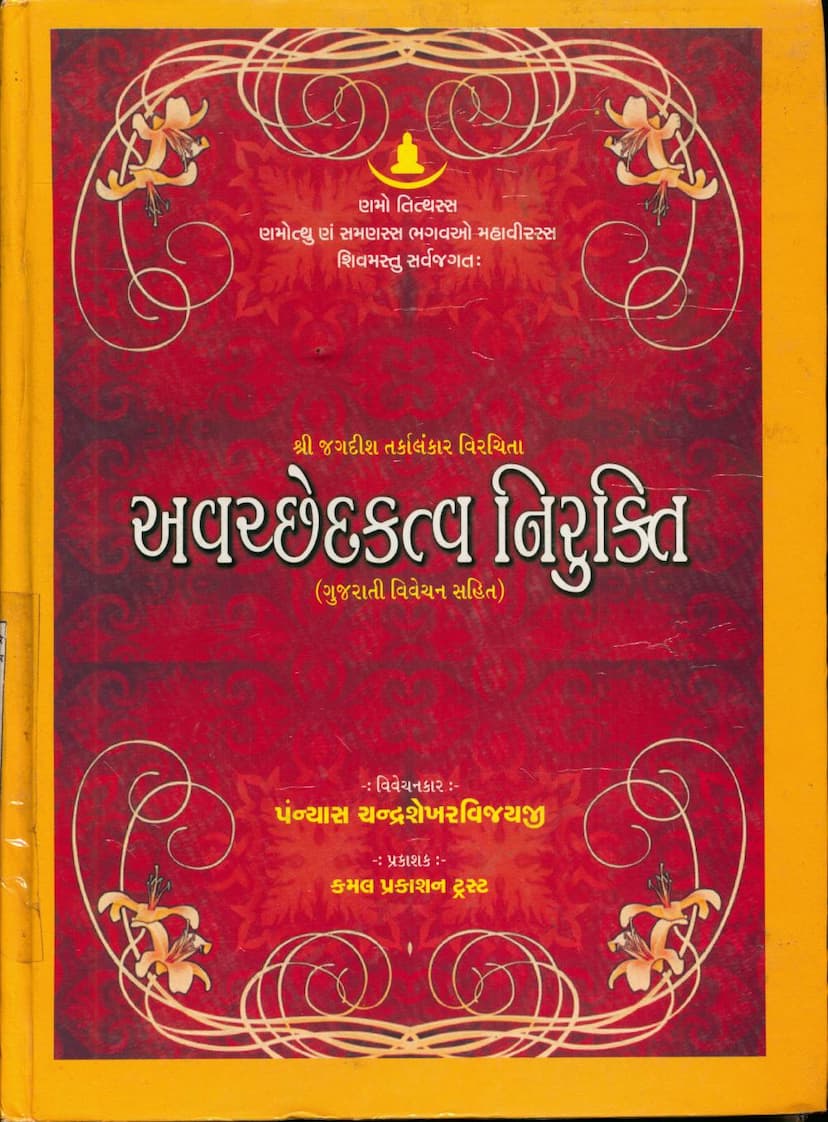Avachedakatva Nirukti
Added to library: September 1, 2025

Summary
This Jain text, "Avachedakatva Nirukti" by Chandrashekharvijay, published by Kamal Prakashan Trust, delves into a complex philosophical concept within Jainism related to "Avachedakatva", which can be understood as the principle of limitation or determination.
The book, as indicated by the provided pages, appears to be a commentary (Dīkā) in Gujarati on a work that discusses "Avachedakatva." The commentary is by Panyas Chandrashekharvijayji, who is a disciple of the esteemed Acharya Bhagvant Shrimad Vijay Premsurishwarji Maharaj Saheb.
Here's a breakdown of the key themes and information gleaned from the text:
Core Concept: Avachedakatva (Limitation/Determination)
- Philosophical Context: The text engages with the concept of "Avachedakatva" within the framework of Jain philosophy, likely in relation to logic, epistemology, or metaphysics. This concept is crucial for understanding how entities are defined, qualified, or distinguished from one another.
- Commentary on "Dīkā": The book is a "Dīkā" (commentary) on a work titled "Jagadīsh Tarkālaṅkāra Virachitā Avachedakatva Ṭīkā." This implies that the original work is by Jagadīsh Tarkālaṅkāra, a renowned scholar, and this text is a detailed explanation of that work.
- Influence of Nyaya Philosophy: The preface and some later pages (especially Page 7 onwards) indicate a strong connection to the Indian philosophical school of Nyaya, particularly the "Navya-Nyaya" (New Nyaya) tradition. This tradition, originating with Gangeśa Upādhyāya, focuses on precise definitions and logical analysis. The text mentions prominent Navya-Nyaya scholars like Vardhamāna, Pakṣadhara, Vācaspati Miśra, Jagadīśa Tarkālaṅkāra, and Gadādhara, highlighting the intellectual lineage of the discussion.
- The "Chintamani": The preface on Page 7 refers to the "Chintamani," a foundational text in Navya-Nyaya, implying that the "Avachedakatva" discussed is in relation to the concepts explored within this influential work.
- The Role of "Avachedakatva" in Defining "Vyāpti": The core debate seems to revolve around how "Avachedakatva" functions in defining "Vyāpti" (pervasion or invariable concomitance), a fundamental concept in Indian logic used to establish inferential knowledge. The text specifically mentions the definition of Vyāpti as "Sādhya-tāvacchedaka-vacchinna-sāmānādhikaraṇya" (co-existence of the major term qualified by the qualifier of the predicate with the minor term qualified by the qualifier of the predicate). The discussion likely scrutinizes the role of "Avachedakatva" in determining these qualifiers.
Author's Perspective and Purpose:
- Author's Background: Panyas Chandrashekharvijayji mentions that he studied these texts about 40 years ago under the guidance of his guru, Pūjya Premasurīśvarjī Mahārāj Saheb. He wrote commentaries in Gujarati during his studies, not anticipating they would be published.
- Purpose of Publication: The primary motivation for publishing this commentary is to assist monks and nuns in their study of Nyaya philosophy.
- Revision and Acknowledgements: The author acknowledges the significant contributions of Muni Ratnajyotvijayji and Muni Saumya Ratnavijayji, and Pandit Santokhbhai in reviewing and improving the text. He also expresses immense gratitude to his disciple, Muni Jinpadmavijay, for his diligent and selfless proofreading.
- Spiritual Aim: The ultimate aspiration is that by studying this text, ascetics will gain profound understanding of the Agamas and achieve liberation (Mukti) sooner.
Key Scholarly Debates and Arguments (as per the lengthy excerpts on pages 10-21):
The text seems to be a deep dive into specific logical arguments concerning "Avachedakatva," likely critiquing or elaborating on the interpretations of scholars like Raghunātha Śiromaṇi (author of "Dīdhiti") and Jagadīśa Tarkālaṅkāra (author of "Jāgadīśī"). The debates appear to touch upon:
- The Nature of Avachedakatva: Is it a unique form of relationship (Svarūpa-sambandha)?
- The Problem of Over-extension (Atiprasaṅga): How to avoid defining "Avachedakatva" in a way that leads to invalid conclusions or includes unintended cases.
- The Role of "Laghu Dharma" (Lighter Properties) vs. "Guru Dharma" (Heavier Properties): When defining something, should the limitation come from a simpler, lighter property or a more complex, heavier one? The text discusses how favoring lighter properties can lead to exceptions.
- The Concept of "Samanīyata" (Concomitance/Co-extension): How does the relationship between properties affect their role as "Avachedakatva"?
- The Distinction between "Vyāpya-vṛtti" (Invariable Concomitance) and "Abhāvā-vṛtti" (Non-existence): Arguments around whether "Avachedakatva" applies to the presence or absence of properties.
- Specific Examples and Counter-arguments: The text heavily engages with examples from Nyaya texts, such as "prameya-dhūmatva" (the property of being smoke that is knowable), "kambu-grīvādimattva" (having a neck like a pitcher), "ghraṇa-grāhyagutva" (property knowable by smell), etc., to illustrate its logical points and counter-arguments.
- The Meaning of "Anuvṛttitv" (Non-excessiveness): Debates on what constitutes "non-excessive" and how it relates to "Avachedakatva."
Ancillary Content:
- Publisher Information: Kamal Prakashan Trust, Ahmedabad, is the publisher.
- Inspirational Messages: Pages 5 and 9 contain messages about the importance of good upbringing, education, and character development for children, emphasizing the values of respect, devotion, and service.
- Promotional Content: Pages 144-146 contain information about "Tapovan Sanskar Peeth," a residential educational institution offering religious and practical education with a focus on character building. It also advertises for young people to conduct religious services (Paryushan) and invites donations for their Sanskrit Pathshala.
In essence, "Avachedakatva Nirukti" is a scholarly exploration of a nuanced logical concept within Jain philosophy, deeply rooted in the analytical traditions of Navya-Nyaya, aiming to provide clarity and guidance for ascetics pursuing spiritual knowledge. The commentary by Chandrashekharvijayji is presented with reverence for his guru and with a clear intention to benefit the monastic community.